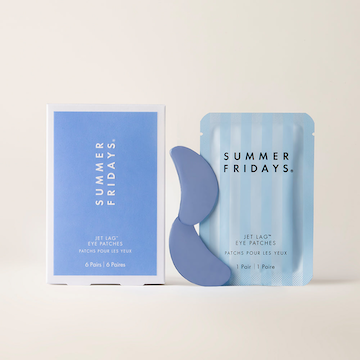The Truth Beneath the Surface
Understanding dark under-eye circles, and what actually helps
By the time the espresso’s gone tepid on the breakfast tray and the morning light falls just so across the mirror, there it is again. That shadow, that persistent hollowness beneath the eye. It speaks of long nights, yes. But sometimes of nothing at all. Not of excess nor sleeplessness, but of something deeper, etched into the structure of the face, the texture of the skin, or the subtle choreography of blood and pigment under the surface.
Dark under-eye circles are among the most universal beauty concerns, and yet they remain widely misunderstood. The mythology is vast, as is the market for miracle cures. But behind the well-lit selfies and the chilled spoons lies a more intricate story. One rooted in biology, behaviour, and often the ineffable quirks of heredity.
The first step, perhaps surprisingly, is not to buy anything at all. It is to see. To observe. That means understanding the four fundamental categories that define most dark circles: pigmentation, vascular visibility, structural shadow, and lifestyle-induced swelling. Not every case is a blend. But many are. And recognising the difference is key.
Pigment: The Family Heirloom
Pigmented circles are typically brown or greyish in tone and, in many cases, are inherited. A glance at old family albums might reveal similar shadows beneath the eyes of siblings, parents or uncles. These darker tones are more common in individuals with medium to deeper skin tones. Those of South Asian or Middle Eastern descent, for instance. Here, melanin activity is naturally more prominent. But pigment alone rarely tells the full story.
There are aggravators. Chronic rubbing, often the unconscious response to irritation or fatigue, can deepen the hue. This kind of repetitive friction stimulates more pigment production in an already melanin-rich area, subtly yet steadily intensifying the shadows.
Vascular: Beneath Thin Skin
If the circles lean bluish, purplish or even a hint red, particularly first thing in the morning, the issue may be vascular. Blood vessels beneath the eyes sit closer to the surface than elsewhere on the face. If circulation is poor or if there’s any congestion, whether from allergies, sinus pressure or simply a fitful night’s sleep, these vessels can become more visible.
The skin in this area is thinner by design, and with age, it becomes even more translucent. This allows the blood’s hue to appear through the surface, creating a tired, drawn look that belies how you might actually feel.
Structure: Shadow and Sunkenness
Then comes the architecture. Some faces are simply built in a way that casts shadows. A natural dip in the tear trough can give the illusion of darkness where none exists. Others experience volume loss with age. Fat pads beneath the skin that once held everything aloft start to shrink or migrate, deepening hollows that weren’t there before.
And even in youth, bone structure plays its part. The contour beneath the eye reflects light differently depending on angles and depth, making some faces appear naturally more hollowed or shadowed than others.
Lifestyle: The Usual Suspects
Lastly, there’s the matter of how we live. And here, the list of culprits reads like the guest list to a particularly raucous night out: salt, sugar, alcohol, screens, cigarettes. But the problem isn’t always hedonism. Sometimes, it’s simply poor sleep, stress, a tearful night or too many hours under the glare of a laptop. Puffiness from fluid retention can press on nearby vessels and emphasise shadowing, especially in combination with the other causes.
Even a diet high in sodium or sugar can contribute. Not by staining the skin but by triggering inflammation and bloating, which only add to the impression of fatigue.
The 10-Second Test: A Diagnosis in Natural Light
To work out what’s at play, a simple at-home ritual can help. Begin by examining the under-eyes in natural daylight, never overhead lighting, which casts unnatural shadows. A photo taken head-on can be a helpful baseline. Then, apply gentle pressure beneath the eye. If the darkness lightens, vascular issues are likely. If it remains unchanged, pigment is probably the cause.
Next, tilt the chin downward and look upward into a mirror. This highlights any hollowing or bulging in the area, pointing toward a structural factor. Finally, reflect honestly on recent habits. Has the week been unusually full of late nights or poor diet? That too may be contributing.
What Not to Do
The instinct is often to act. But in this case, restraint is elegance. There’s a litany of supposed hacks that are best avoided.
Many creams, especially expensive ones, are little more than rich moisturisers in ornate jars. They do not address pigment, inflammation or vascular pooling. La Prairie, for instance, offers a beautifully packaged eye cream that lacks any active ingredient targeting under-eye issues. The better choice is to seek purpose-built formulas.
DIY remedies are another slippery slope. Lemon juice, baking soda and even coffee grounds are frequently touted online, but they can irritate the delicate eye area or cause microtears. Potato slices, used in some cultures for their cooling starches, offer only fleeting relief. The same goes for ice cubes and cold spoons. They constrict vessels and reduce puffiness, yes, but only for minutes, not hours.
Overuse of potent actives like retinol can backfire as well. The skin under the eye is delicate. High concentrations of exfoliants or retinoids can irritate rather than renew, leading to more pronounced darkness due to inflammation. Glycolic acid at 15 percent is a clear case of too much of a good thing.
What Might Work
For pigmentation, the options are limited but not nonexistent. Hydroquinone has shown some success, particularly in patients with darker complexions. However, it must be cycled and used with care. Gentler, over-the-counter ingredients like kojic acid, alpha arbutin, licorice root extract and niacinamide can offer modest improvement over time.
Vitamin C can also help, though its most potent form, ascorbic acid, may irritate sensitive eyes. Instead, opt for esterified versions like tetrahexyldecyl ascorbate, which tend to be more stable and less reactive. Retinol, when used at low concentrations and specifically formulated for the eye area, can assist with cell turnover and skin thickening over time.
One rule remains constant. Consistency over intensity. Think of it as caring for silk, not denim.
For vascular concerns, niacinamide once again earns its place. It reduces inflammation and helps strengthen the skin’s barrier. Caffeine, when used topically, can constrict blood vessels temporarily. Products with arnica, such as those found in certain rollerball applicators, aid circulation while minimising puffiness. Arnica works best when it hasn’t been diluted in homeopathic formulations. Seek the ingredient in its true botanical form.
If your skin is especially translucent, retinoids at low strength can thicken the dermis over time. And for a boost that feels indulgent if not transformative, refrigerated eye patches from brands like Summer Fridays or Dieux offer temporary relief and a welcome coolness.
When Creams Can’t Cut It
If the issue is structural, however, no cream will ever be enough. Despite what some may claim, no topical treatment can replace lost volume beneath the eye. Collagen-boosting serums, however promising, do not reach the deeper tissues. In these cases, an in-office treatment is required.
Depending on individual anatomy, this might mean PRP or PRF injections, using one’s own blood components to stimulate healing and tissue strength. Light hyaluronic acid fillers applied judiciously can help. So too can newer injectables such as Rejuran, a salmon DNA-based treatment used in some East Asian clinics. These are not replacements for surgery, but they can improve the appearance when expertly applied.
Refining Habits
And then there’s lifestyle. Perhaps the simplest, yet the hardest to shift. Reducing alcohol and sodium can have a profound effect. Just one or two drinks a month, rather than weekly, can bring back a sense of clarity to the complexion. Sugar, too, plays a role in inflammation. A diet high in fresh greens, clean proteins and water often shows first beneath the eyes.
Sleep, of course, is essential. But so is how one winds down. Screens at night, stress, overwork. All leave their mark eventually. A cold roller paired with a calming serum can help in the short term. But no tool replaces a changed rhythm.
Seeing Clearly
In the end, there’s no one-size-fits-all solution. The circles beneath our eyes are as individual as fingerprints. Some are inherited, some earned, some self-inflicted. What matters is understanding their origin. Only then can one begin to treat the cause rather than chase after fleeting fixes.
There is beauty in the honesty of our faces. Not every shadow needs to be erased. But it helps to know which ones can be softened, and how.














